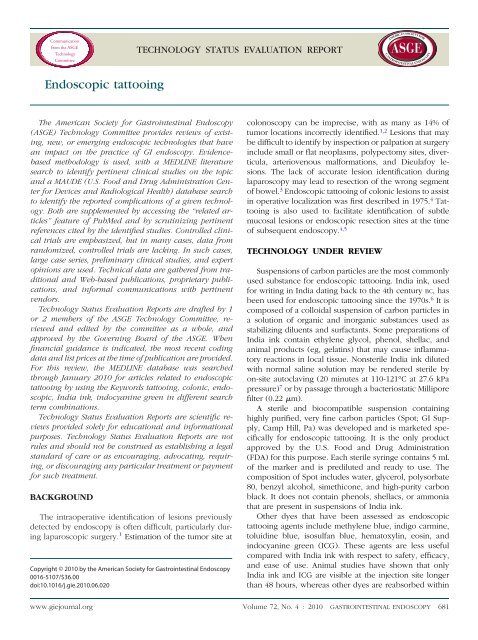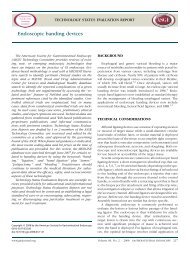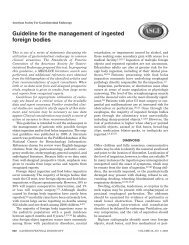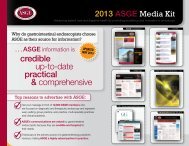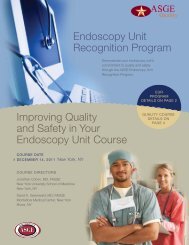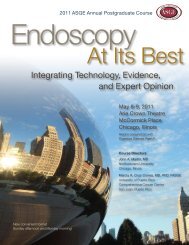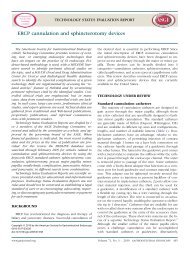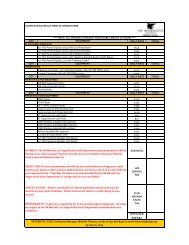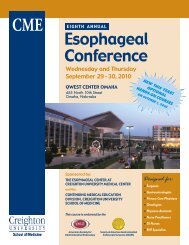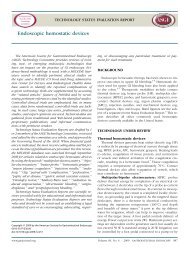Endoscopic tattooing - American Society for Gastrointestinal ...
Endoscopic tattooing - American Society for Gastrointestinal ...
Endoscopic tattooing - American Society for Gastrointestinal ...
Create successful ePaper yourself
Turn your PDF publications into a flip-book with our unique Google optimized e-Paper software.
TECHNOLOGY STATUS EVALUATION REPORT<strong>Endoscopic</strong> <strong>tattooing</strong>The <strong>American</strong> <strong>Society</strong> <strong>for</strong> <strong>Gastrointestinal</strong> Endoscopy(ASGE) Technology Committee provides reviews of existing,new, or emerging endoscopic technologies that havean impact on the practice of GI endoscopy. Evidencebasedmethodology is used, with a MEDLINE literaturesearch to identify pertinent clinical studies on the topicand a MAUDE (U.S. Food and Drug Administration Center<strong>for</strong> Devices and Radiological Health) database searchto identify the reported complications of a given technology.Both are supplemented by accessing the “related articles”feature of PubMed and by scrutinizing pertinentreferences cited by the identified studies. Controlled clinicaltrials are emphasized, but in many cases, data fromrandomized, controlled trials are lacking. In such cases,large case series, preliminary clinical studies, and expertopinions are used. Technical data are gathered from traditionaland Web-based publications, proprietary publications,and in<strong>for</strong>mal communications with pertinentvendors.Technology Status Evaluation Reports are drafted by 1or 2 members of the ASGE Technology Committee, reviewedand edited by the committee as a whole, andapproved by the Governing Board of the ASGE. Whenfinancial guidance is indicated, the most recent codingdata and list prices at the time of publication are provided.For this review, the MEDLINE database was searchedthrough January 2010 <strong>for</strong> articles related to endoscopic<strong>tattooing</strong> by using the Keywords <strong>tattooing</strong>, colonic, endoscopic,India ink, indocyanine green in different searchterm combinations.Technology Status Evaluation Reports are scientific reviewsprovided solely <strong>for</strong> educational and in<strong>for</strong>mationalpurposes. Technology Status Evaluation Reports are notrules and should not be construed as establishing a legalstandard of care or as encouraging, advocating, requiring,or discouraging any particular treatment or payment<strong>for</strong> such treatment.BACKGROUNDThe intraoperative identification of lesions previouslydetected by endoscopy is often difficult, particularly duringlaparoscopic surgery. 1 Estimation of the tumor site atCopyright © 2010 by the <strong>American</strong> <strong>Society</strong> <strong>for</strong> <strong>Gastrointestinal</strong> Endoscopy0016-5107/$36.00doi:10.1016/j.gie.2010.06.020colonoscopy can be imprecise, with as many as 14% oftumor locations incorrectly identified. 1,2 Lesions that maybe difficult to identify by inspection or palpation at surgeryinclude small or flat neoplasms, polypectomy sites, diverticula,arteriovenous mal<strong>for</strong>mations, and Dieulafoy lesions.The lack of accurate lesion identification duringlaparoscopy may lead to resection of the wrong segmentof bowel. 3 <strong>Endoscopic</strong> <strong>tattooing</strong> of colonic lesions to assistin operative localization was first described in 1975. 4 Tattooingis also used to facilitate identification of subtlemucosal lesions or endoscopic resection sites at the timeof subsequent endoscopy. 4,5TECHNOLOGY UNDER REVIEWSuspensions of carbon particles are the most commonlyused substance <strong>for</strong> endoscopic <strong>tattooing</strong>. India ink, used<strong>for</strong> writing in India dating back to the 4th century BC, hasbeen used <strong>for</strong> endoscopic <strong>tattooing</strong> since the 1970s. 6 It iscomposed of a colloidal suspension of carbon particles ina solution of organic and inorganic substances used asstabilizing diluents and surfactants. Some preparations ofIndia ink contain ethylene glycol, phenol, shellac, andanimal products (eg, gelatins) that may cause inflammatoryreactions in local tissue. Nonsterile India ink dilutedwith normal saline solution may be rendered sterile byon-site autoclaving (20 minutes at 110-121°C at 27.6 kPapressure) 7 or by passage through a bacteriostatic Milliporefilter (0.22 m).A sterile and biocompatible suspension containinghighly purified, very fine carbon particles (Spot; GI Supply,Camp Hill, Pa) was developed and is marketed specifically<strong>for</strong> endoscopic <strong>tattooing</strong>. It is the only productapproved by the U.S. Food and Drug Administration(FDA) <strong>for</strong> this purpose. Each sterile syringe contains 5 mLof the marker and is prediluted and ready to use. Thecomposition of Spot includes water, glycerol, polysorbate80, benzyl alcohol, simethicone, and high-purity carbonblack. It does not contain phenols, shellacs, or ammoniathat are present in suspensions of India ink.Other dyes that have been assessed as endoscopic<strong>tattooing</strong> agents include methylene blue, indigo carmine,toluidine blue, isosulfan blue, hematoxylin, eosin, andindocyanine green (ICG). These agents are less usefulcompared with India ink with respect to safety, efficacy,and ease of use. Animal studies have shown that onlyIndia ink and ICG are visible at the injection site longerthan 48 hours, whereas other dyes are reabsorbed withinwww.giejournal.org Volume 72, No. 4 : 2010 GASTROINTESTINAL ENDOSCOPY 681
<strong>Endoscopic</strong> <strong>tattooing</strong>24 hours. 8 ICG is a vital stain originally used <strong>for</strong> quantifyingcardiac output. ICG cannot be used in patients withallergy to iodine.INDICATIONS AND EASE OF USE<strong>Endoscopic</strong> <strong>tattooing</strong> is indicated to facilitate localizationof a luminal abnormality at the time of surgery orrepeat endoscopic examination. The <strong>tattooing</strong> agent isdelivered by an injection needle advanced through theworking channel of the endoscope. 9 The needle should beinserted at an oblique angle to the bowel wall to avoidpenetrating the serosa. 10 Transmural injection may resultin diffuse staining of the peritoneal surface. Once theneedle’s bevel is within the submucosa, the agent is injectedto raise a bleb, usually in 0.5- to 1.0-mL aliquots.Four-quadrant injection around the circumference of thebowel has been suggested to optimize operative localization.11 This is particularly important in the colon because itis difficult to identify the location intraoperatively if thetattoo is only placed on the mesenteric or retroperitonealside of the colon. 12 The use of 2 injections to bracket alesion <strong>for</strong> subsequent endoscopic inspection has also beendescribed. 5 When using India ink, it must be sterilized anddiluted be<strong>for</strong>e use, whereas the FDA-approved Spot isprediluted and ready to use.More recently, “saline test injection” techniques havebeen described to define the submucosal plane to preventdye infiltration of the muscularis propria or spillage intothe peritoneum. 13 In one technique, saline solution is firstinjected into the submucosa to ensure <strong>for</strong>mation of asubmucosal bleb. 14 The syringe with saline solution is thenreplaced by a syringe containing India ink while the needleis still in the submucosal plane. After injection of theink, the saline solution syringe is reattached and used toexpel the residual India ink in the injection catheter. Thismethod was used in 55 cases and was more effective <strong>for</strong>operative identification than the conventional technique(54/55 vs 31/36; P .034). The same method was used inanother study using Spot. 12 This study confirmed that thetechnique was safe and effective <strong>for</strong> operative tumor localization(61/63; 96.8%). A 2-step variation of this techniquehas been described in which saline solution is firstinjected to create a submucosal elevation. 15 This is followedby a separate puncture of the bleb with an needlecontaining India ink and injection of a small amount ofIndia ink. Leakage of residual India ink from the 2puncture sites resulted in smaller, more precise tattooswithout broad tissue staining based on subjective operativefindings.India ink has been used <strong>for</strong> endoscopic marking ofesophageal lesions, in particular Barrett’s esophagus. In aprospective study, 19 patients with Barrett’s esophagushad India ink tattoos placed at the most proximal level ofthe squamocolumnar junction. 16 Of the 15 patients whoremained in the study, all had good tattoo persistence at 36months. No complications related to esophageal <strong>tattooing</strong>were reported.Mucosa marking targeting biopsy has been described asa method <strong>for</strong> longitudinal follow-up in multifocal atrophicgastritis and precancerous lesions in the stomach. In thistechnique, <strong>tattooing</strong> of biopsy sites is used as a means toidentify previously sampled areas. 17 <strong>Endoscopic</strong> <strong>tattooing</strong>has also been used during deep enteroscopy (eg, doubleballoonenteroscopy) to mark the extent of antegradeinspection <strong>for</strong> identification during subsequent retrogradeenteroscopy. 18Another reported application of endoscopic <strong>tattooing</strong>based on limited case series is EUS-guided fine-needle<strong>tattooing</strong> using India ink or ICG <strong>for</strong> the preoperative localizationof pancreatic lesions. 19-21OUTCOMES AND COMPARATIVE DATAVarious concentrations of India ink were studied in ananimal model. 22 Undiluted and 1:10 dilution resulted inmucosal ulceration. Tattoos created with 0.5-mL aliquotsof 1:100 India ink produced no gross inflammation andwere seen consistently at colonoscopy, laparoscopy, andlaparotomy <strong>for</strong> as long as 5 months.The safety and efficacy of Spot were evaluated in astudy of 113 patients. 23 Fever, abdominal pain, or signs orsymptoms of inflammation did not develop in any of thepatients. Ten patients with colon polyps deemed endoscopicallyunresectable or malignant appearing had the area surroundingthe lesions tattooed and subsequently underwentsurgical resection. At operation, the tattoos were visible in allcases, and none of the resected specimens exhibited necrosisor abscess <strong>for</strong>mation on histopathology. An additional 103patients underwent colonoscopic <strong>tattooing</strong> and subsequentlyunderwent colonoscopy or underwent surgery at anotherhospital. In the 42 patients who underwent subsequentcolonoscopy 3 to 12 months after <strong>tattooing</strong>, all tattoos werereadily identifiable.<strong>Endoscopic</strong> <strong>tattooing</strong> with ICG in 12 patients was visibleat surgery 36 hours after injection and resulted in onlyminimal inflammation. 24 In another study of 39 patients,ICG was visible intraoperatively in all 29 patients havingsurgery within 8 days. In the remaining 10 patients whounderwent surgery more than 8 days after <strong>tattooing</strong>, stainingwas seen in only 2 patients. 25An animal study considered the safety and efficacy ofvarious dilutions of India ink and ICG. 19 Although thetattoo with 1:100 dilution of India ink was seen consistently<strong>for</strong> as long as 5 months with only a mild submucosalreaction, ICG was visible only on day 1 and caused mucosalulceration and mild to severe inflammation at boththe concentrated and diluted injection sites. To enhancedetection of tattoos created with lower concentrations ofICG, fluorescence imaging with light-emitting, diodeactivatedICG has been described. 26 Although this newtechnique is reported to be safe and effective, it will add682 GASTROINTESTINAL ENDOSCOPY Volume 72, No. 4 : 2010 www.giejournal.org
<strong>Endoscopic</strong> <strong>tattooing</strong>TABLE 1. Tattooing agentsTattooing agentIndocyanine green(Cardiogreen)ManufacturerSigma-Aldrich Inc,St. Louis, MoFDA-approved<strong>for</strong> <strong>tattooing</strong> Price Special featuresNo $46.70 <strong>for</strong> 25 mg, $80.60<strong>for</strong> 50 mgAvailable in powder <strong>for</strong>m, not readily solublein saline solution, soluble in waterIndia ink(Endomark)PMT/Permark Inc,Chanhassen, MinnNo10-mL vials, $30 each;box of 9 <strong>for</strong> $225Sterile, diluted 1:50 with normal salinesolutionSpotGI Supply Inc,Camp Hill, PaYes 5-mL syringe, box of 10<strong>for</strong> $199Sterile, ready-to-use, prepackaged syringessignificant cost because the imaging requires a speciallight and camera.Alternative localization techniques have included metalclips, fluoroscopy, barium enema, CT colonography, magneticresonance imaging, and intraoperative colonoscopy.27,28 There are no studies comparing endoscopic <strong>tattooing</strong>with these alternative methods of localization.SAFETYInjection of appropriately diluted and sterile solutions isgenerally safe, with most complications related to transmuralinjection. A retrospective study of 195 patients undergoing4-quadrant <strong>tattooing</strong> with 0.2- to 0.5-mL aliquotsof sterile 1:100 India ink found no short-term complications.29 A retrospective analysis of 447 cases of colonic<strong>tattooing</strong> by using various India ink preparations found acomplication in only 1 patient in whom abdominal pain,tenderness, and fever developed after <strong>tattooing</strong> a cauteryinducedulcer. 6 In a prospective study of India ink <strong>tattooing</strong>in 55 patients, no clinical complications were noted. 30After an average of 36 months of follow-up, there were noendoscopically visible inflammatory changes and evaluationof 74 biopsy specimens from these patients revealedno histologic changes at the tattoo sites in 48 patients, mildchronic inflammation in 6 patients, and hyperplasticchanges in 1 patient. Other case reports of complicationsafter colonic <strong>tattooing</strong> with India ink include an isolatedcase of idiopathic inflammatory bowel disease, 3 abdominalabscesses, 2 cases of inflammatory pseudotumor, 1case of focal peritonitis, and instances of peritonealstaining. 5,31-35 In all these case reports, India ink was injectedeither undiluted or at a 1:1 or 1:10 dilution.In a study of 63 patients who had <strong>tattooing</strong> with Spot, 6patients (9.5%) had peritoneal leakage based on findingsat surgery; mild peritonitis developed in only 1 patient. 12Another case study of 3 patients who underwent endoscopic<strong>tattooing</strong> by using this agent reported intraoperativeidentification of black macular patches or streaks atextraintestinal sites including the peritoneum and mesentery.This is thought to be caused by either intraperitonealspillage of the dye from deep injection or migration ofpigment-laden macrophages via lymphatic channels. 36 AMAUDE database search <strong>for</strong> Spot resulted in 1 report of apatient I whom fever, abdominal pain, and abnormal liverenzymes developed after injection at the hepatic flexure. 37In a single case report, injection of dye too close to amalignant lesion or contacting the tumor with the needletip during <strong>tattooing</strong> was reported to cause needle-trackimplantation at a site distinct from the tumor. 13FINANCIAL CONSIDERATIONSThe list prices of currently available sterile preparations of<strong>tattooing</strong> agents are listed in Table 1. The CPT (CurrentProcedural Terminology)* codes <strong>for</strong> “directed submucosalinjection(s), _any substance” are used <strong>for</strong> endoscopic <strong>tattooing</strong>.For esophagoscopy with directed submucosal injection(s),report CPT 43201; <strong>for</strong> EGD, the CPT code is 43236.For sigmoidoscopy, the applicable code is 45335, and <strong>for</strong>colonoscopy, proximal to the splenic flexure; with directedsubmucosal injection(s), any substance, the code is 45381. Inother intestine sites, use of code 44799 (unlisted service,intestine) would be appropriate, providing the report and acover letter to the payer requesting payment equivalent tothe services denoted by the specific CPT codes noted. Nationalcorrect coding bundling edits exclude same-day reportingof the base codes within these sections (eg, 45330 or43235) but do not require specific modifiers to report separateservices such as biopsy and polypectomy. Payment istypically based on multiple-procedure (51 modifier) or familyof code (59 modifier) rules, but varies with the payer. Moreguidance is provided in the ASGE Coding Primer, A Guide<strong>for</strong> Gastroenterologists (2009). 38*Current Procedural Terminology (CPT) is copyright 2010 <strong>American</strong> MedicalAssociation. All Rights Reserved. No fee schedules, basic units,relative values, or related listings are included in CPT. The AMA assumesno liability <strong>for</strong> the data contained herein. Applicable FARS/DFARS restrictionsapply to government use.www.giejournal.org Volume 72, No. 4 : 2010 GASTROINTESTINAL ENDOSCOPY 683
<strong>Endoscopic</strong> <strong>tattooing</strong>AREAS OF FUTURE RESEARCHSpot is the only FDA-approved endoscopic <strong>tattooing</strong>agent. The data on long-term safety and effectiveness ofthis agent are limited. Studies comparing different <strong>tattooing</strong>agents are needed. In addition, other localization techniquesusing endoscopic metallic clips or CT-colonography shouldbe compared with <strong>tattooing</strong> techniques. The utility of shorterlength needles should be evaluated to prevent inadvertentdeep intestinal injection leading to peritoneal spillage. Finally,more studies are needed to define the added benefit ofEUS-guided fine-needle <strong>tattooing</strong> relative to preoperative localizationusing imaging alone.SUMMARY<strong>Endoscopic</strong> <strong>tattooing</strong> is an effective means to enablesubsequent endoscopic and surgical localization of luminaldigestive tract lesions. India ink has been used effectivelyin a large number of cases over several decades.When diluted (1:100 with normal saline solution) andinjected tangentially in small aliquots (0.5-1 mL), India ink<strong>tattooing</strong> is safe and long-lasting. One purified carbonparticle suspension is the only FDA-approved agent <strong>for</strong>this indication and its ready-to-use <strong>for</strong>mulation offers convenience.ICG has been used less frequently and appearsto be safe but provides a less durable tattoo.REFERENCES1. Cho YB, Lee WY, Yun HR, et al. Tumor localization <strong>for</strong> laparoscopic colorectalsurgery. World J Surg 2007;31:1491-5.2. Vignati P, Welch JP, Cohen JL. <strong>Endoscopic</strong> localization of colon cancers.Surg Endosc 1994;8:1085-7.3. Wexner SD, Cohen SM, Ulrich A, et al. Laparoscopic colorectal surgery—are webeing honest with our patients? Dis Colon Rectum 1995;38:723-7.4. Ponsky JL, King JF. <strong>Endoscopic</strong> marking of colonic lesions. GastrointestEndosc 1975;22:42-3.5. Shatz BA, Thavorides V. Colonic tattoo <strong>for</strong> follow-up of endoscopicsessile polypectomy. Gastrointest Endosc 1991;37:59-606. Nizam R, Siddiqi N, Landas SK, et al. Colonic <strong>tattooing</strong> with India ink:benefits, risks, and alternatives. Am J Gastroenterol 1996;91:1804-8.7. Salamon P, Berner JS, Waye JD. <strong>Endoscopic</strong> India ink injection: a method<strong>for</strong> preparation, sterilization, and administration. Gastrointest Endosc1993;39:803-5.8. Hammond DC, Lane FR, Welk RA, et al. <strong>Endoscopic</strong> <strong>tattooing</strong> of the colon:an experimental study. Am Surg 1989;55:457-61.9. ASGE Technology Committee: Conway JD, Adler DG, Diehl DL, et al.<strong>Endoscopic</strong> hemostatic devices. Gastrointest Endosc 2009;69:987-96.10. Fennerty MB, Sampliner RE, Hixson LJ, et al. Effectiveness of India Ink asa long-term colonic mucosal marker. Am J Gastroenterol 1992;87:79-81.11. Hyman N, Waye JD. <strong>Endoscopic</strong> four quadrant tattoo <strong>for</strong> the identificationof colonic lesions at surgery. Gastrointest Endosc 1991;37:56-8.12. Park JW, Sohn DK, Hong CW, et al. The usefulness of preoperativecolonoscopic <strong>tattooing</strong> using a saline test injection method with prepackagedsterile India ink <strong>for</strong> localization in laparoscopic colorectal surgery.Surg Endosc 2008;22:501-5.13. Raju GS. What is new in <strong>tattooing</strong>? Custom <strong>tattooing</strong>. Gastrointest Endosc2004;59:328-9.14. Fu KI, Fujii T, Kato S, et al. A new endoscopic <strong>tattooing</strong> technique <strong>for</strong> identifyingthe location of colonic lesions during laparoscopic surgery: a comparisonwith the conventional technique. Endoscopy 2001;33:687-91.15. Sawaki A, Nakamura T, Suzuki T, et al. A two-step method <strong>for</strong> markingpolypectomy sites in the colon and rectum. Gastrointest Endosc 2003;57:735-7.16. Shaffer RT, Francis JM, Carrougher JG, et al. India ink <strong>tattooing</strong> in theesophagus. Gastrointest Endosc 1998;47:257-62.17. Sun L, Si J, Chen S, Liu W, et al. The establishment and clinical applianceof technique of mucosa marking targeting biopsy. Hepatogastroenterology2009;56:59-62.18. Akahoshi K, Kubokawa M, Matsumoto M, et al. Double-balloon endoscopyin the diagnosis and management of GI tract diseases: methodology,indications, safety, and clinical impact. World J Gastroenterol 2006;12:7654-9.19. Price N, Gottfried MR, Clary E, et al. Safety and efficacy of India ink andindocyanine green as colonic <strong>tattooing</strong> agents. Gastrointest Endosc2000;51:438-42.20. Gress FG, Barawi M, Kim D, et al. Preoperative localization of a neuroendocrinetumor of the pancreas with EUS-guided fine needle <strong>tattooing</strong>.Gastrointest Endosc 2002;55:594-7.21. Farrell JJ, Sherrod A, Parekh D. EUS-guided fine-needle <strong>tattooing</strong> <strong>for</strong>preoperative localization of early pancreatic adenocarcinoma. GastrointestEndosc 2009;69:176-7.22. Ashida R, Yamao K, Okubo K, et al. Indocyanine green is an ideal dye <strong>for</strong>endoscopic ultrasound-guided fine-needle <strong>tattooing</strong> of pancreatic tumors.Endoscopy 2006;38:190-2.23. Askin MP, Waye JD, Fiedler L, et al. Tattoo of colonic neoplasms in 113patients with a new sterile carbon compound. Gastrointest Endosc2002;56:339-42.24. Hammond DC, Lane FR, Mackeigan JM, et al. <strong>Endoscopic</strong> <strong>tattooing</strong> ofthe colon: clinical experience. Am Surg 1993;59:205-10.25. Miyoshi N, Ohue M, Noura S, et al. Surgical usefulness of indocyaninegreen as an alternative to India ink <strong>for</strong> endoscopic marking. Surg Endosc2009;23:347-51.26. Watanabe M, Tsunoda A, Narita K, et al. Colonic <strong>tattooing</strong> using fluorescenceimaging with light-emitting diode-activated indocyanine green:a feasibility study. Surg Today 2009;39:214-8.27. Tabibian N, Michaletz PA, Schwartz JT, et al. Use of endoscopicallyplaced clip can avoid diagnostic errors in colonoscopy. Gastrointest Endosc1988;34:262-5.28. Frager DH, Frager JD, Wolf EL, et al. Problems in the colonoscopic localizationof tumors: continued value of the barium enema. GastrointestRadiol 1987;12:343-6.29. McArthur CS, Roayaie S, Waye JD. Safety of preoperation endoscopictattoo with India ink <strong>for</strong> identification of colonic lesions. Surg Endosc1999;13:397-400.30. Shatz BA, Weinstock LB, Swanson PE, et al. Long-term safety of India inktattoos in the colon. Gastrointest Endosc 1997;45:153-6.31. Gopal DV, Morava-Protzner I, Miller HAB, et al. Idiopathic inflammatorybowel disease associated with colonic <strong>tattooing</strong> with India inkpreparation—case report and review of the literature. Gastrointest Endosc1999;49:636-9.32. Park SI, Genta RS, Romeo DP, et al. Colonic abscess and focal peritonitissecondary to India ink <strong>tattooing</strong> of the colon. Gastrointest Endosc 1991;137:68-71.33. Coman E, Brandt LJ, Brenner S, et al. Fat necrosis and inflammatorypseudotumor due to endoscopic <strong>tattooing</strong> of the colon with India ink.Gastrointest Endosc 1991;37:65-8.34. Alba LM, Pandya PK, Clarkston WK. Rectus muscle abscess associatedwith endoscopic <strong>tattooing</strong> of the colon with India ink. Gastrointest Endosc2000;52:557-8.35. Dell’Abate P, Iosca A, Galimberti P, et al. <strong>Endoscopic</strong> preoperative colonic<strong>tattooing</strong>: a clinical and surgical complication. Endoscopy 1999;31:271-3.36. Cappell MS, Courtney JT, Amin M. Black macular patches on parietalperitoneum and other extraintestinal sites from intraperitoneal spillageand spread of India ink from preoperative endoscopic <strong>tattooing</strong>: an endoscopic,surgical, gross pathologic, and microscopic study. Dig Dis Sci2009 Dec 3 [Epub ahead of print].684 GASTROINTESTINAL ENDOSCOPY Volume 72, No. 4 : 2010 www.giejournal.org
<strong>Endoscopic</strong> <strong>tattooing</strong>37. MAUDE (Manufacturer and user facility device experience) database.Available at: http://www.accessdata.fda.gov/scripts/cdrh/cfdocs/cfMAUDE/detail.cfm?mdrfoi__id879793. Accessed on January 31, 2010.38. Littenberg G, editor. The ASGE coding primer: a guide <strong>for</strong> gastroenterologists.Oak Brook (Ill): ASGE; 2009. p. 34-42; 75.Prepared by:ASGE TECHNOLOGY COMMITTEESripathi R. Kethu, MDSubhas Banerjee, MDDavid Desilets, MD, PhDDavid L. Diehl, MDFrancis A. Farraye, MD, MScVivek Kaul, MDRichard S. Kwon, MDPetar Mamula, MD, NASPGHAN representativeMarcos C. Pedrosa, MD, MPHSarah A. Rodriguez, MDLouis-Michel Wong Kee Song, MDWilliam M. Tierney, MD, Committee ChairThis document is a product of the ASGE Technology AssessmentCommittee. This document was reviewed and approved by theGoverning Board of the <strong>American</strong> <strong>Society</strong> <strong>for</strong> <strong>Gastrointestinal</strong>Endoscopy.www.giejournal.org Volume 72, No. 4 : 2010 GASTROINTESTINAL ENDOSCOPY 685


